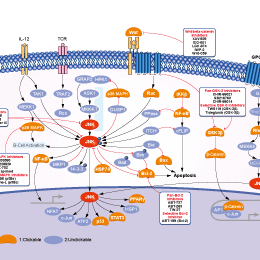
- Bioactive Compounds
- By Signaling Pathways
- PI3K/Akt/mTOR
- Epigenetics
- Methylation
- Immunology & Inflammation
- Protein Tyrosine Kinase
- Angiogenesis
- Apoptosis
- Autophagy
- ER stress & UPR
- JAK/STAT
- MAPK
- Cytoskeletal Signaling
- Cell Cycle
- TGF-beta/Smad
- DNA Damage/DNA Repair
- Compound Libraries
- Popular Compound Libraries
- Customize Library
- Clinical and FDA-approved Related
- Bioactive Compound Libraries
- Inhibitor Related
- Natural Product Related
- Metabolism Related
- Cell Death Related
- By Signaling Pathway
- By Disease
- Anti-infection and Antiviral Related
- Neuronal and Immunology Related
- Fragment and Covalent Related
- FDA-approved Drug Library
- FDA-approved & Passed Phase I Drug Library
- Preclinical/Clinical Compound Library
- Bioactive Compound Library-I
- Bioactive Compound Library-Ⅱ
- Kinase Inhibitor Library
- Express-Pick Library
- Natural Product Library
- Human Endogenous Metabolite Compound Library
- Alkaloid Compound LibraryNew
- Angiogenesis Related compound Library
- Anti-Aging Compound Library
- Anti-alzheimer Disease Compound Library
- Antibiotics compound Library
- Anti-cancer Compound Library
- Anti-cancer Compound Library-Ⅱ
- Anti-cancer Metabolism Compound Library
- Anti-Cardiovascular Disease Compound Library
- Anti-diabetic Compound Library
- Anti-infection Compound Library
- Antioxidant Compound Library
- Anti-parasitic Compound Library
- Antiviral Compound Library
- Apoptosis Compound Library
- Autophagy Compound Library
- Calcium Channel Blocker LibraryNew
- Cambridge Cancer Compound Library
- Carbohydrate Metabolism Compound LibraryNew
- Cell Cycle compound library
- CNS-Penetrant Compound Library
- Covalent Inhibitor Library
- Cytokine Inhibitor LibraryNew
- Cytoskeletal Signaling Pathway Compound Library
- DNA Damage/DNA Repair compound Library
- Drug-like Compound Library
- Endoplasmic Reticulum Stress Compound Library
- Epigenetics Compound Library
- Exosome Secretion Related Compound LibraryNew
- FDA-approved Anticancer Drug LibraryNew
- Ferroptosis Compound Library
- Flavonoid Compound Library
- Fragment Library
- Glutamine Metabolism Compound Library
- Glycolysis Compound Library
- GPCR Compound Library
- Gut Microbial Metabolite Library
- HIF-1 Signaling Pathway Compound Library
- Highly Selective Inhibitor Library
- Histone modification compound library
- HTS Library for Drug Discovery
- Human Hormone Related Compound LibraryNew
- Human Transcription Factor Compound LibraryNew
- Immunology/Inflammation Compound Library
- Inhibitor Library
- Ion Channel Ligand Library
- JAK/STAT compound library
- Lipid Metabolism Compound LibraryNew
- Macrocyclic Compound Library
- MAPK Inhibitor Library
- Medicine Food Homology Compound Library
- Metabolism Compound Library
- Methylation Compound Library
- Mouse Metabolite Compound LibraryNew
- Natural Organic Compound Library
- Neuronal Signaling Compound Library
- NF-κB Signaling Compound Library
- Nucleoside Analogue Library
- Obesity Compound Library
- Oxidative Stress Compound LibraryNew
- Plant Extract Library
- Phenotypic Screening Library
- PI3K/Akt Inhibitor Library
- Protease Inhibitor Library
- Protein-protein Interaction Inhibitor Library
- Pyroptosis Compound Library
- Small Molecule Immuno-Oncology Compound Library
- Mitochondria-Targeted Compound LibraryNew
- Stem Cell Differentiation Compound LibraryNew
- Stem Cell Signaling Compound Library
- Natural Phenol Compound LibraryNew
- Natural Terpenoid Compound LibraryNew
- TGF-beta/Smad compound library
- Traditional Chinese Medicine Library
- Tyrosine Kinase Inhibitor Library
- Ubiquitination Compound Library
-
Cherry Picking
You can personalize your library with chemicals from within Selleck's inventory. Build the right library for your research endeavors by choosing from compounds in all of our available libraries.
Please contact us at info@selleckchem.com to customize your library.
You could select:
- Antibodies
- Bioreagents
- qPCR
- 2x SYBR Green qPCR Master Mix
- 2x SYBR Green qPCR Master Mix(Low ROX)
- 2x SYBR Green qPCR Master Mix(High ROX)
- Protein Assay
- Protein A/G Magnetic Beads for IP
- Anti-Flag magnetic beads
- Anti-Flag Affinity Gel
- Anti-Myc magnetic beads
- Anti-HA magnetic beads
- Poly DYKDDDDK Tag Peptide lyophilized powder
- Protease Inhibitor Cocktail
- Protease Inhibitor Cocktail (EDTA-Free, 100X in DMSO)
- Phosphatase Inhibitor Cocktail (2 Tubes, 100X)
- Cell Biology
- Cell Counting Kit-8 (CCK-8)
- Animal Experiment
- Mouse Direct PCR Kit (For Genotyping)
- New Products
- Contact Us
research use only
SP600125 JNK inhibitor
SP600125 (Nsc75890) is a broad-spectrum JNK inhibitor for JNK1, JNK2 and JNK3 with IC50 of 40 nM, 40 nM and 90 nM in cell-free assays, respectively; 10-fold greater selectivity against MKK4, 25-fold greater selectivity against MKK3, MKK6, PKB, and PKCα, and 100-fold selectivity against ERK2, p38, Chk1, EGFR etc. This compound is also a broad‐spectrum inhibitor of serine/threonine kinases including Aurora kinase A,FLT3 and TRKA with of IC50 of 60 nM, 90 nM and 70 nM. It inhibits autophagy and activates apoptosis.
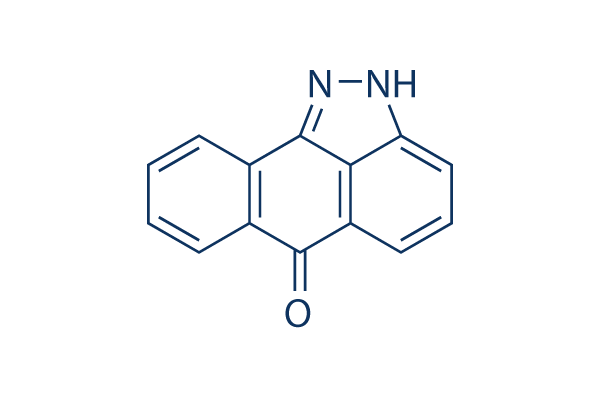
Chemical Structure
Molecular Weight: 220.23
Purity & Quality Control
Batch:
Purity:
99.94%
99.94
Products Often Used Together with SP600125
It inhibits autophagy and activates apoptosis whereas, Adezmapimod induces mitophagy and autophagy.
It and PD98059 are two kinases that possess pro-survival activities in TQ-induced cell death.
It and Bentamapimod are pan-JNK inhibitors that cause a robust reduction in cell viability in a panel of GBM stem cells (GSCs) cultures.
Related Products
| Related Targets | JNK1 JNK2 JNK3 | Click to Expand |
|---|---|---|
| Related Products | JNK-IN-8 Anisomycin JNK Inhibitor IX Tanzisertib HCl(CC-930) JNK Inhibitor VIII Bentamapimod (AS602801) BI-78D3 SP 600125, negative control DTP3 CC-401 Hydrochloride Polyphyllin I | Click to Expand |
| Related Compound Libraries | Kinase Inhibitor Library MAPK Inhibitor Library Cell Cycle compound library TGF-beta/Smad compound library Anti-alzheimer Disease Compound Library | Click to Expand |
Signaling Pathway
Cell Culture and Working Concentration
| Cell Lines | Assay Type | Concentration | Incubation Time | Formulation | Activity Description | PMID |
|---|---|---|---|---|---|---|
| Hep3B | Function Assay | 10 μM | 1 h | Blocks autophagy and upregulation of Beclin 1 expression induced by ceramide | 19060920 | |
| BV-2 | Function Assay | 2 μM | 1 h | Inhibits the increase of sBAFF release in Gmix-treated BV-2 cells | 19406831 | |
| RAW264.7 | Function Assay | 10 μM | 12 h | Antiinflammatory activity assessed as inhibition of LPS-induced NO production with IC50 of 17μM | 19497418 | |
| PC3 | Function Assay | 20 μM | 1 h | Decreases the MMP2 and MMP9 expression | 19633975 | |
| Plasmodium falciparum HB3 | Antibacterial Assay | 72 h | DMSO | Antiplasmodial activity with IC50 of 7.94328 μM | 19734910 | |
| Plasmodium falciparum W2 | Antibacterial Assay | 72 h | DMSO | Antiplasmodial activity with IC50 of 7.94328 μM | 19734910 | |
| Plasmodium falciparum 7G8 | Antibacterial Assay | 72 h | DMSO | Antiplasmodial activity with IC50 of 10 μM | 19734910 | |
| Plasmodium falciparum 3D7 | Antibacterial Assay | 72 h | DMSO | Antiplasmodial activity with IC50 of 12.5893 μM | 19734910 | |
| Plasmodium falciparum GB4 | Antibacterial Assay | 72 h | DMSO | Antiplasmodial activity with IC50 of 12.5893μM | 19734910 | |
| HaCaT | Function Assay | 20 μM | 4 h | DMSO | Blocks the TNF-α-induced CYP4F11 transcription | 19812349 |
| HaCaT | Function Assay | 20 μM | 24 h | DMSO | Blocks the phosphorylation of c-Jun protein | 19812349 |
| A549 | Function Assay | 20 μM | 1 h | Inhibition of TPA-induced MMP-2 and u-PA expression | 20492175 | |
| PC12 | Function Assay | 10 μM | 5 h | DMSO | Activation of Nrf2/ARE assessed as HO-1 protein induction pretreated with PD98059 | 21345685 |
| PC12 | Function Assay | 10 μM | 5 h | DMSO | Activation of Nrf2/ARE assessed as HO-1 protein induction pretreated with U0126 | 21345685 |
| PC12 | Function Assay | 10 μM | 5 h | DMSO | Activation of Nrf2/ARE assessed as HO-1 protein induction pretreated with SP600125 | 21345685 |
| PC12 | Function Assay | 10 μM | 5 h | DMSO | Activation of Nrf2/ARE assessed as HO-1 protein induction pretreated with SB203580 | 21345685 |
| B16-F10 | Function Assay | 1 h | Inhibition of TNF-alpha-induced c-JUN phosphorylation | 21815634 | ||
| LoVo | Function Assay | 1 μM | 1 h | Inhibition of PGE2-induced expression of uPA and MMP-9 significantly | 21859479 | |
| LoVo | Function Assay | 1 μM | 1 h | BlocksPGE2-induced cell migration significantly | 21859479 | |
| THP-1 | Function Assay | 90 nM | 30 min | Inhibition of tissue factor expression | 22940059 | |
| PC3 | Function Assay | 25 μM | 24 h | Inhibition of AP-1 and p21 luciferase activity induced by S179D PRL | 23162652 | |
| SH-SY5Y | Function Assay | 10 μM | 1 h | DMSO | Neuroprotective activity assessed as reduction of anisomycin-induced cell death | 23498914 |
| SH-SY5Y | Kinase Assay | 10 μM | 1 h | DMSO | Inhibition of JNK3 assessed as blockade of anisomycin-induced c-jun phosphorylation at ser73 | 23498914 |
| RAW264.7 | Function Assay | 10 μM | 24 h | Antiinflammatory activity assessed as inhibition of IL-1beta release | 23791078 | |
| RAW264.7 | Function Assay | 10 μM | 24 h | Antiinflammatory activity assessed as inhibition of LPS-induced iNOS expression | 23791078 | |
| RAW264.7 | Function Assay | 10 μM | 2 h | Antiinflammatory activity assessed as inhibition of LPS-induced NO production | 23791078 | |
| A549 | Growth Inhibition Assay | 20 μM | 72 h | DMSO | Rapid and potent inhibition of cell proliferation | 23912840 |
| RAW264.7 | Antiinflammatory assay | Antiinflammatory activity in mouse RAW264.7 cells assessed as inhibition of LPS-induced NO production relative to control, IC50 = 17 μM. | 22831798 | |||
| BMMC | Function assay | 1 to 20 uM | 7 days | Inhibition of RANKL/M-CSF-stimulated osteoclastogenesis in ICR mouse BMMC assessed as reduction in TRAP positive multinucleated cells at 1 to 20 uM incubated for 7 days by light microscopy | 25397676 | |
| A673 | qHTS assay | qHTS of pediatric cancer cell lines to identify multiple opportunities for drug repurposing: Primary screen for A673 cells | 29435139 | |||
| BT-37 | qHTS assay | qHTS of pediatric cancer cell lines to identify multiple opportunities for drug repurposing: Primary screen for BT-37 cells | 29435139 | |||
| SK-N-SH | qHTS assay | qHTS of pediatric cancer cell lines to identify multiple opportunities for drug repurposing: Primary screen for SK-N-SH cells | 29435139 | |||
| NB1643 | qHTS assay | qHTS of pediatric cancer cell lines to identify multiple opportunities for drug repurposing: Primary screen for NB1643 cells | 29435139 | |||
| OHS-50 | qHTS assay | qHTS of pediatric cancer cell lines to identify multiple opportunities for drug repurposing: Primary screen for OHS-50 cells | 29435139 | |||
| SK-N-MC | qHTS assay | qHTS of pediatric cancer cell lines to identify multiple opportunities for drug repurposing: Primary screen for SK-N-MC cells | 29435139 | |||
| NB-EBc1 | qHTS assay | qHTS of pediatric cancer cell lines to identify multiple opportunities for drug repurposing: Primary screen for NB-EBc1 cells | 29435139 | |||
| LAN-5 | qHTS assay | qHTS of pediatric cancer cell lines to identify multiple opportunities for drug repurposing: Primary screen for LAN-5 cells | 29435139 | |||
| Click to View More Cell Line Experimental Data | ||||||
Mechanism of Action
| Targets |
|
|---|
In vitro |
||||
| In vitro | SP600125 is originally characterized as a selective ATP-competitive inhibitor of c-Jun N-terminal kinase JNK. In Jurkat T cells, this compound inhibits the phosphorylation of c-Jun with IC50 of 5 μM to 10 μM. In CD4+ cells, such as Th0 cells isolated from either human cord or peripheral blood, it blocks cell activation and differentiation and inhibits the expression of inflammatory genes COX-2, IL-2, IL-10, IFN-γ, and TNF-α, with IC50 of 5 μM to 12 μM. [1] However, later studies reveal that this chemical also suppresses aryl hydrocarbon receptor (AhR) [2], Mps1 [3], and a panel of other serine/threonine kinases, including Aurora kinase A, FLT3, MELK, and TRKA [4]. In a mouse beta cells MIN6, this compound (20 μM) induces the phosphorylation of p38 MAPK and its downstream CREB-dependent promoter activation. [5] In HCT116 cells, it (20 μM) blocks the G2 phase to mitosis transition and induces endoreplication. This ability of this inhibitor is independent of JNK inhibition, but due to its inhibition of CDK1-cyclin B activation upstream of Aurora A and Polo-like kinase 1. [6] |
|||
|---|---|---|---|---|
| Kinase Assay | In Vitro Kinase Assays | |||
| The potency of SP600125 towards kinases, including MPS1, JNK, and Aurora kinase A, is determined based on the specific measurement of radioactive phosphotransfer to the substrate. For each enzyme, the absolute Km values for ATP and the specific substrate are initially determined and each assay is then run at optimized [ATP] (2·αKm) and [substrate] (5·Km) concentrations. MPS1 activity is measured using 5 nM of MPS1 recombinant protein in 50 mM HEPES pH 7.5, 2.5 mM MgCl2, 1 mM MnCl2, 1 mM DTT, 3 μM NaVO3, 2 mM β-glycerophosphate, 0.2 mg/mL BSA, 200 μM P38-βtide substrate-peptide (KRQADEEMTGYVATRWYRAE), and 8 μM ATP with 1.5 nM 33P-γ-ATP. Ten serial 1:3 dilutions (from 30 μM to 1.5 nM) of this compound are tested and IC50 determined. | ||||
| Cell Research | Cell lines | HCT116, A2780, and U2OS cells | ||
| Concentrations | 0–5 μM | |||
| Incubation Time | 72 hours | |||
| Method | Cells are seeded in 384 well-plates. One day after seeding, the cells are treated with SP600125 for 72 hours and the plates are then processed using a CellTiter-Glo assay. Inhibitory activity is evaluated comparing treated versus control data and IC50 value of proliferation is calculated. |
|||
| Experimental Result Images | Methods | Biomarkers | Images | PMID |
| Western blot | p-JNK p-IGF1R / IGF1R / p-Akt / Akt / p-ERK / ERK p-Src / Src p-c-Jun / c-Jun / pJNK / JNK Survivin / Bcl-2 / PARP p-FADD / FADD / p-c-Jun / c-Jun |
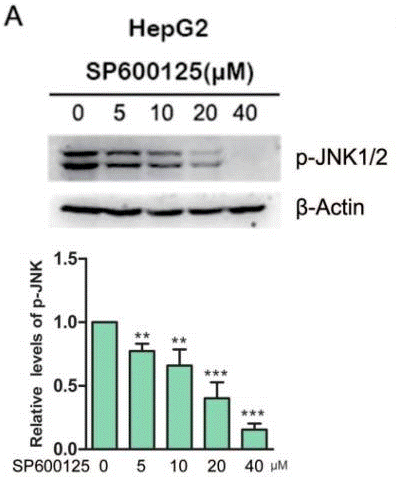
|
25226534 | |
| Immunofluorescence | AIF / Endo G E-cadherin / β-catenin α-catenin / Actin |
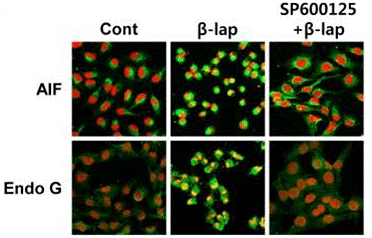
|
21738692 | |
| Growth inhibition assay | Cell viability (U-87 MG) Cell viability (A549) |
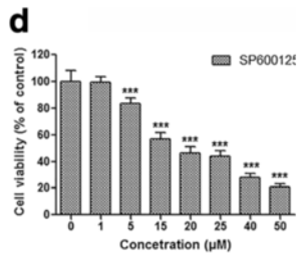
|
27176481 | |
In Vivo |
||
| In vivo | In mice, SP600600125 (15 mg/kg or 30 mg/kg) significantly inhibits lipopolysaccharide (LPS)-induced TNF-α expression and anti-CD3-induced apoptosis of CD4+ CD8+ thymocytes. [1] |
|
|---|---|---|
| Animal Research | Animal Models | Mouse LPS/TNF model (female CD-1) |
| Dosages | 15 or 30 mg/kg | |
| Administration | Administered via intravenous injection or orally | |
References |
|
Chemical Information
| Molecular Weight | 220.23 | Formula | C14H8N2O |
| CAS No. | 129-56-6 | SDF | Download SDF |
| Synonyms | Nsc75890 | ||
| Smiles | C1=CC=C2C(=C1)C3=NNC4=CC=CC(=C43)C2=O | ||
Storage and Stability
| Storage (From the date of receipt) | |||
|
In vitro |
DMSO : 60 mg/mL ( (272.44 mM) Moisture-absorbing DMSO reduces solubility. Please use fresh DMSO.) Water : Insoluble Ethanol : Insoluble |
Molecular Weight Calculator |
|
In vivo Add solvents to the product individually and in order. |
In vivo Formulation Calculator |
|||||
Preparing Stock Solutions
Molarity Calculator
In vivo Formulation Calculator (Clear solution)
Step 1: Enter information below (Recommended: An additional animal making an allowance for loss during the experiment)
mg/kg
g
μL
Step 2: Enter the in vivo formulation (This is only the calculator, not formulation. Please contact us first if there is no in vivo formulation at the solubility Section.)
% DMSO
%
% Tween 80
% ddH2O
%DMSO
%
Calculation results:
Working concentration: mg/ml;
Method for preparing DMSO master liquid: mg drug pre-dissolved in μL DMSO ( Master liquid concentration mg/mL, Please contact us first if the concentration exceeds the DMSO solubility of the batch of drug. )
Method for preparing in vivo formulation: Take μL DMSO master liquid, next addμL PEG300, mix and clarify, next addμL Tween 80, mix and clarify, next add μL ddH2O, mix and clarify.
Method for preparing in vivo formulation: Take μL DMSO master liquid, next add μL Corn oil, mix and clarify.
Note: 1. Please make sure the liquid is clear before adding the next solvent.
2. Be sure to add the solvent(s) in order. You must ensure that the solution obtained, in the previous addition, is a clear solution before proceeding to add the next solvent. Physical methods such
as vortex, ultrasound or hot water bath can be used to aid dissolving.
Tech Support
Answers to questions you may have can be found in the inhibitor handling instructions. Topics include how to prepare stock solutions, how to store inhibitors, and issues that need special attention for cell-based assays and animal experiments.
Tel: +1-832-582-8158 Ext:3
If you have any other enquiries, please leave a message.
* Indicates a Required Field
Frequently Asked Questions
Question 1:
how to reconstitute the inhibitor for in vivo studies?
Answer:
S1460 can be dissolved in 5% DMSO/corn oil at 5 mg/ml as a clear solution for injection. The inhibitor dissolved in vehicle 30% PEG400/0.5% Tween80/5%Propylene glycol, at 30mg/ml is a suspension and can be used for oral administration.






































